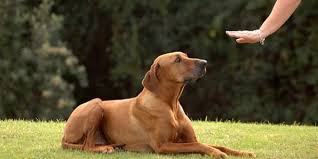 Before beginning to shape any behavior be sure to load the clicker so the dog knows what it means.
Before beginning to shape any behavior be sure to load the clicker so the dog knows what it means.
Free Shaping involves slicing the behavior you want your dog to do into tiny pieces, successively clicking and treating each slice until you have built up the finished behavior that you want to train. Shaping a behavior takes more time and skill but the dog learns the behavior more reliably because he has to figure it out on his own. Free shaping is training behaviors by rewarding small approximations of those behaviors without the use of luring or prompting. Free shaping behaviors can turn the most dud like (my agility and scent detection dog!), scatterbrained, unmotivated dogs into training maniacs, that is how and why I began to do clicker training.

You can free shape the down by clicking just a slight dip of the head, and then a bigger head dip, then shoulders leaning down and so forth, until you have a down. This game works because dogs learn very quickly what gets them treats, they remember that and offer it. If the slight dip of the head has been reinforced enough times they will keep offering that head dip, even if you stop reinforcing it. Dogs are hopeful, and when they figure out that the head dip does not get them treats anymore, they will start adding improvements on the head dip, such as lowering the shoulders. It is the handlers job to catch those improvements and click them. That is called raising the criteria. Knowing when to stop reinforcing one approximation of a behavior and hold out for more is more of an art than science. As a rule of thumb, if your dog looks like he is losing interest or giving up when you start holding out for an improvement, you have probably raised the criteria too quickly. Go back and reinforce the behavior he was offering the last few times. Once that behavior is strengthened by a few more reinforcements, you can try to hold out again for the next approximation. If your dog has offered three behaviors and they have not been what you want, drop back on your criteria and take a little less so your dog gets a reward on the forth try. The rule of three is a generalization to get you started, you will quickly learn how to read your dog and know when to raise the training criteria and how long you should hold out. When your dog finally does the final behavior, throw a party! Rejoice, yell and dole out about 10 treats. This is known as a jackpot and it is used to mark a great behavior. When you are jackpotting, it is much more effective to dole out 10 small treats in rapid succession than to give one large chunk of bait. Dogs will eat anything that can fit in their mouths in one bite. Amazingly they have no sense of proportion, but they can count. Many tiny pieces are much more valuable to a dog than one big chunk. I will use part of my dogs meals as treats. The pieces should not be larger than your baby fingernail.When I am training with treats it comes out of their meal. Steak, chicken and liver are more rewarding than plain old kibble. I feed all my dogs human grade only.

If you have trouble getting a behavior and want to throw in a little lure, no one is going to die. To use a lure, get down on the floor and make a bridge by bending your knees. Lure your dog under your leg and as he ducks his head down click that. You can approximate the down just the same way as if you were free shaping it, but you are getting the dog started by luring him into a position where he is likely to start offering the behavior. If your dog is big like in Paula’s case, sit in a chair or on a low stool and prop your leg up on a milk crate.
When using a lure to teach the down, you might be tempted to click only when the dog actually lays down, rather than clicking each approximation. Your dog will learn how to lay down that way, however the behavior will be stronger and more reliable if you click and treat each approximation. So click and treat as soon as the dogs elbows begin to bend. Then give a big jackpot to reinforce the idea that down is a great position to be in.
The next step is to add a cue (command). The cue used will be determined on if you shaped the behavior or lured it. If you free shaped it, just add the verbal cue, I use” down”. If you lured the down , it’s easy to use a similar hand motion with the lure to cue the down. You can then start fading the food by hiding it in the palm of your hand as you lure the down. Once the dog is responding to the hand motion reliably without seeing the food, try it without the food hidden in your palm.
I will then energize the behavior with a hot reinforcer. The hotter the reinforcer, the better. If your dog goes bananas over , say a ball or toy, nothing is more useful than teaching him to assume the down position before getting his treasured object. Not only will this teach him to learn to love to lie down, it will teach him self control. He has to do a calm behavior in order to earn an exciting one.
I will then take it on the road gradually to proof the behavior..






